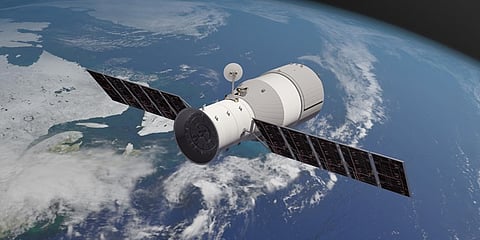

By Dr Aswin Sekhar
Not every year a top space power nation informs the United Nations that they have lost control of their official space station!
“We understand from a December 2017 communication from the Permanent Mission of China to the United Nations that China’s Tiangong-1 space laboratory will re-enter the Earth’s atmosphere in early 2018,” commented Dr Dwayne Brown, Senior Communications Official, NASA HQ. This official communication from China to mission diplomats started the prediction game!
This official message is a pretty rare incident in history and this fact alone turned the Chinese space station Tiangong-1’s re-entry event into media frenzy and led to intense global coverage! American radars situated at different points across the globe are closely monitoring the trajectory and fate of this space station for many months now.
Tiangong-1 is roughly 10 metres in size and weighs about 8 tonnes. The nature of its impact on Earth would totally depend on the geometry, shape and orientation of the object during its crash course. The velocity of re-entry would also depend on the surface area and orientation of the object in its final hours.
In general, the re-entry speed inside Earth’s atmosphere for this object is expected to be in the range of 100 miles/hour and could be even slower if a large surface area is exposed in the direction of the fall. Larger air resistance and greater friction can make the body burn up in atmosphere much quicker in certain angles depending on specific aerodynamic geometry compared to other formats!
“Most likely only about 5-10% of space station remnants would survive the atmospheric burning phase and impact the Earth. The probability of such remnants hitting the ocean is far higher compared to them hitting any piece of land. The probability of these fragments causing any damage to humans or property is even more unlikely when we compare it with past events” says Dr Jonathan McDowell, a senior solar system dynamicist from International Astronomical Union-Minor Planet Center (which is the record keeper of all celestial bodies with an extensive database) based at Harvard.
“The exact nature of disintegration depends on the material and metal with which the space station is made. Even if the fragments hit the ground, it is not going to be a single large fragment weighing tonnes. It is most likely going to be a cluster of small objects (with sizes from 10 cm to 1 m) weighing some kilograms each, moving in similar path,” adds Dr McDowell. In other words, it will be roughly like a string of metallic beads tracing a somewhat identical path in the sky.
“If one looks at the rank of this man-made object re-entry, it is almost likely the 50th in the list in descending order of size and mass. Most of these 50 objects in the past have fallen in the sea and only a very small fraction has been recovered from land. There was only one incident from 1997 in Oklahoma where a small space debris fell directly on the shoulder of an American lady, but luckily it was totally safe and did not lead to any injury or disaster” he remarks.
“Even assuming perfect knowledge, any potential fragments generated following re-entry breakup would spread out somewhat randomly over a ground track on average hundreds of kilometres long and a few tens of kilometres wide, which is why the risk of hitting a person on the ground is very, very low” comments Dr Stijn Lemmens, an analyst working in European Space Agency’s Space Debris Office at Darmstadt, Germany.
The crucial question here is the exact location and timing of the impact the space station will have on Earth. The uncertainty in this calculation comes from instantaneous space weather. Like any weather forecast, space weather too comes with lots of probabilistic, stochastic and predictive elements. This is akin to the inability of predicting our exact local weather for more than few days ahead with any absolute certainty.
“The density in the atmosphere changes quickly and those changes can affect the trajectory predictions of the space station’s orbit. Hence, the orbit changes on a day-to-day basis depending on how thin or thick the atmosphere is. Slowly and steadily one gets to narrow down the coordinates for the location and time of collision. During these times, there is going to be constant monitoring from various radars and detectors from the US and other sites in the world,” explains Dr McDowell.
“In order for these models to do their orbital determination and prediction jobs, they require so-called ‘proxies’ to describe how space weather affects spaceflight, e.g. how much energy the Sun is sending to Earth, and how these radiation and particle streams interact with the near-Earth environment” adds Dr Lemmens.
This event could occur anytime between April 1 or April 2 depending on the exact space weather conditions at the time. It is only an hour or two in advance, one will get to know the precise location and timing of impact.
Moreover, there will be joint cooperation and collaboration in this regard from various astronomically advanced countries to observe and collect samples, if anything manages to survive that is. After all, space is something which affects all of us equally, beyond the typical geographical borders and boundaries! Sky and space usually unites us all in more ways than one!
The author, Dr Aswin Sekhar, is an Indian astrophysicist working at University of Oslo, Norway.